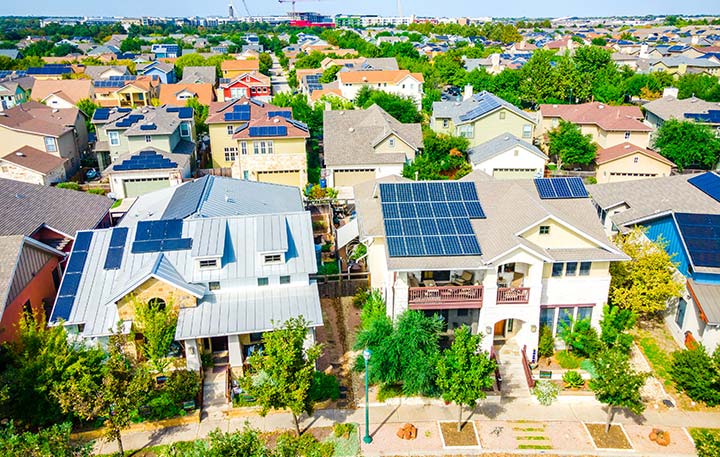County-Level Energy Data and Analysis Empowers Local Energy Planning

For 75% of U.S. counties, full build-out of residential rooftop solar on all suitable rooftops could produce 38%–62% of annual residential electricity consumed, whereas commercial rooftop solar could produce 21%–55% of annual commercial electricity consumed. Photo from iStock
March 28, 2022—Seventy-five percent of U.S. counties could generate a median of 48% of their annual residential electricity consumption from rooftop solar, according to new research on the potential of local renewable energy deployment by the Joint Institute for Strategic Energy Analysis (JISEA) and the National Renewable Energy Laboratory (NREL).
In addition, 75% of U.S. counties could generate a median of 35% of commercial electricity consumption from commercial rooftop solar. Overall, with full build-out of all suitable land and rooftop area, large-scale wind energy would have the lowest levelized cost of electricity of the five renewable technologies analyzed; and utility solar photovoltaics (PV) would have the lowest capital costs and highest median county-level generation potential.
This work is part of the JISEA Sustainable Communities Catalyzer that is helping map pathways for sustainable, local clean energy transitions through new research capabilities and analysis.
"As more and more local governments set clean energy targets and explore their potential to meet these goals locally, our analysis can help state and local energy planners prioritize the most cost-effective local renewable energy deployment," said Megan Day, JISEA/NREL analyst and lead of the Sustainable Communities Catalyzer.
Modeling Local Renewable Energy Technical Generation Potential and Cost
The State and Local Planning for Energy (SLOPE) platform—developed by the U.S. Department of Energy and NREL—served as the analytical backbone for this study.
SLOPE delivers maps and data on energy consumption, renewable energy technical generation potential, energy efficiency potential, levelized cost of electricity, transportation energy and electrification potential, demographics, and building stock—all at the jurisdiction level. No other platform provides the same level of data at hyper-local fidelity as SLOPE.
"Clean energy planning increasingly happens at the city and county level," Day said. "State and national trends in renewable energy technical generation potential and cost don't always apply at the county level due to differences in local land use, climate, topography, and more. Therefore, it's important to use local-level modeling to inform investment priorities and energy planning."
JISEA/NREL compared SLOPE data on technical generation potential and levelized cost of electricity for utility, residential, and commercial photovoltaic (PV) systems, land-based wind, and concentrating solar power (CSP) versus electricity consumption in every county of the United States.
Results: Utility Solar and Land-Based Wind Have the Highest Potential, Lowest Costs
Study results show the potential of local renewable energy generation to meet local energy demand is not solely determined by the local solar or wind resource—some lower-resource areas have higher potential; and costs can depend on local factors such as land use patterns and electricity consumption.
As modeled, land-based wind and utility PV have the highest technical generation potential and are more cost-effective than outfitting all suitable buildings with rooftop PV. To meet local electricity consumption, all counties could deploy rooftop PV, 98% could deploy utility-scale PV or wind, and 44% could deploy CSP.
Overall, land-based wind could produce local electricity for the lowest cost, followed by utility PV, commercial rooftop PV, CSP, and residential rooftop PV.
"SLOPE shows for much of the country a more diversified, local, and renewable generation mix is cost-effective and technically feasible," Day said. "Our analysis illustrates the economies of scale advantages of local utility PV and wind in driving down costs and meeting local energy demand."
Read the full report and learn more about the Sustainable Communities Catalyzer.
Back to JISEA News >
